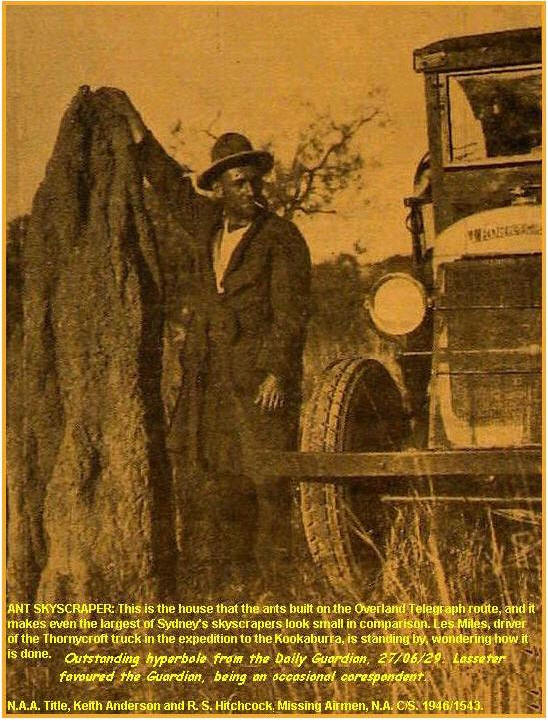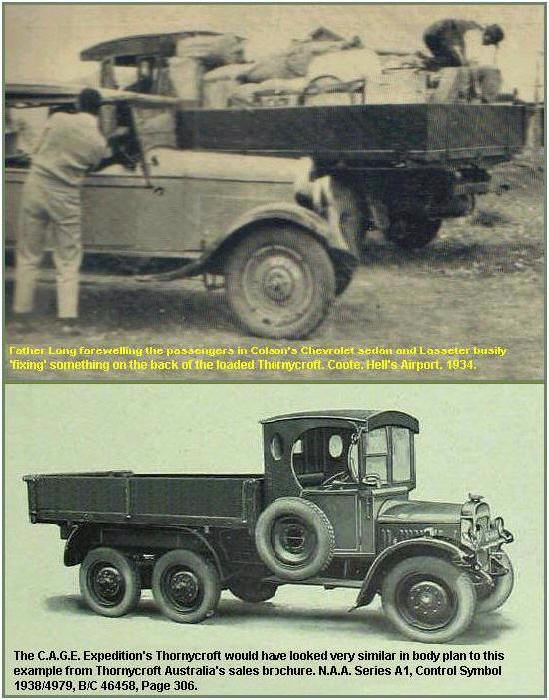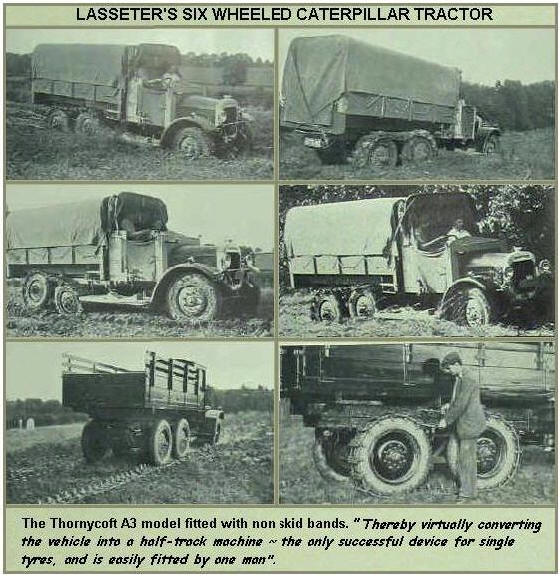272. THORNYCROFT. |
|||
| "only camels could go where the old Thornycroft couldn't". | |||
| Blakeley, Fred. Dream Millions. 9. | |||
|
The first expeditions Thornycroft truck was named 'DIGGER', entirely appropriate considering the expeditions goals and maybe ironic, the heavy vehicle frequently dug its way into sand bogs, and perhaps Coote, who came to detest the truck, found 'Digger' a trenchant reminder of an undistinguished military career. Digger was an A3, rigid chassis, six wheeled motor truck and indeed a fine example of British engineering in 1930, ahead of the times in many ways or 'cutting edge' in today's vernacular. Digger and antecedents have been slighted over the years, especially by Coote, "we cursed that truck properly". It's time to set the record straight. Lasseter showed an early interest in using six wheeled transport in the search for his reef, very likely inspired by the publicity surrounding the successful recovery of the bodies of Anderson and Hitchcock in May 1930. Thornycroft Australia generously donated one of their much vaunted A3 six wheeled trucks on this sad mission and by all accounts the vehicle performed well over the 1553 mile expedition. The Minister for Home Affairs was moved to telegram Thornycroft on 28/06/29, "I saw the lorry at Alice Springs immediately after its return and it did not show the slightest sign of wear. The mechanical success is a triumph for British Manufacturers". Digger's credentials were now well established and well publicised, as Lasseter had noted.
In several letters to Herbert Gepp, the Director of the Development and Migration Commission, Lasseter emphasised the surety and safety of using six wheeled transport over aircraft in the search for the reef, and in correspondence to the Western Australian Mines Department mentioned that he would prefer to travel to the reef in a six wheeled caterpillar tractor. Gepp lent some support to Lasseter's wish by writing in his report on gold prospecting in remote areas, "Our idea was that properly equipped parties, supplied with motor transport of the six wheeled type, and fed from time to time, if necessary, by an aeroplane service, would be able to make a much closer examination of the mineral possibilities of the centre of the continent". Gepp made numerous copies of his report and sent one to Arthur Blakeley who passed it on to John Bailey. A plan writ for C.A.G.E. A. G. Hebblewhite, the managing director of Thornycroft Australia was quick to sense the newly formed C.A.G.E syndicate with their plans to prospect Central Australia would be ideal publicity for the rigid chassis, six wheeled A3 model Thornycroft truck. On the syndicate's second meeting on 21/05/30 and with great fanfare, Hebblewhite donated the use of a six wheeler for six months, "He felt sure that his firm had the best truck in Australia". The heavily loaded truck with Lasseter aboard left Sydney by rail on the 9th of July and arrived in Broken Hill the following Saturday. Because he could not drive, Lasseter made arrangements through Glasson's Garage for Jim Carter to drive the truck to Quorn in South Australia where the Commonwealth Railways trained the vehicle to Alice Springs. There are few photographs of the Expeditions truck, two photos from 'Hell's Airport' show the loaded and unloaded vehicle in Alice Springs with Lasseter fiddling about the stores, either, "fixing something -- a habit with him" or "infernally busy". Possibly the best of the photos were taken by Philip Taylor but these were lost in the fire at Ayers Rock. With Taylor at the wheel, Digger, carrying the bulk of the Expeditions supplies and looking "the best that Great Britain had to offer" left Alice Springs on 24/07/30 but travelled just a couple of miles before the first mishap. Taylor new to the odd steering ratio of the vehicle, bogged in the sandy bed of the Charles River, "However he soon backed out, for it was a powerful thing in reverse", the convoy of three vehicles proceeded north, then west, and more or less on 'good roads' to Archie Giles station. Thereafter the Thornycroft made her own road to Illbilla and beyond.
The Expeditions Thornycroft had a carrying capacity of three tons on good roads, with the explicit qualification by the manufacturer that "The load should be reduced according to the severity of the country traversed". Blakeley's confused record of loadings has the vehicle a ton or more overweight and he surely underestimated the terrain west of Alice Springs, he included his bicycle in the Thornycroft's load. Blakeley had no idea what lay ahead and the truck was probably overloaded by a factor of three and it's credit to Taylor's clever driving that springs weren't broken more frequently. Overloading certainly contributed to numerous punctures and frequent bogging...and overheating, the men quickly noticed the Thornycroft was a thirsty beast. But nothing could mitigate the damage from the Mulga forests, the stake like roots shredded the standard 36 inch by 6 inch tyres and halving Blakeley's daily toll of punctures still left plenty of work for Taylor and Micky at the end of a long day. The stout springy branches eventually removed all external fittings, smashed the windscreen, bent the cab askew and useless and the bumper bar was replaced with a gidgee log, and there was other damage that only Philip Taylor with a welding plant could fix. There were no Mulga forests on Thornycroft's proving grounds, or sand dunes of the like that made it impossible to steer the heavy truck, the sand so fine and 'runny' that it quickly filled any depression made by the tyres and the laborious task of matting continued. As the Mulga had destroyed externally, the sand ground away internally, the oil canals were becoming clogged with the insidious material and the consequences became all too evident several weeks into the journey. And Australia's unique spinifex plains sometimes had the low slung vehicle bellied and quite helpless on the accumulated mass of spiky tussocks and sand, most certainly a "brute of a job" to remove. The truck had clearance of less than 13 inches In his belated reply to the Western Australian Mines Department, Lasseter stated that he preferred to travel to his reef in a six wheeled caterpillar tractor, and during the course of reading the Kookaburra Expedition file several references were made to caterpillar fittings for the Thornycroft. The Melbourne Argus of 24/05/29, reported that, "To make travelling through some of the sandy country more easy the truck will be fitted with caterpillar traction, as it will be heavily laden". It seems Lasseter had been following the widely reported progress of the expedition very closely. And in reply to a last minute thought from the Department of Home Affairs, Thornycroft Australia advised that 200 feet of matting for sandy country would not be needed as the truck had, "caterpillar fittings and a large number of gears". Perhaps Lasseter would have just cause to berate Blakeley for not including the caterpillar fittings in the kit and they appear much easier to handle than 50 foot rolls of sand clogged, thorn ridden matting. Still it may have been too complicated and new fangled for Blakeley.
The Thornycroft steadily disintegrated over the two months in the field, what the Mulga left Taylor removed, the mudguards to clearly see the steering wheels on the narrow strips of matting and the engine covers to ease the overheated motor. And always the running repairs, the windscreen was replaced with timber from packing crates, with just a narrow gap for the driver to peer through, no one fancied a blinding swipe across the face from a Mulga branch. A sheet of perforated metal from the dry blower became a seed baffle placed in front of the radiator, the emergency fresh water condenser was modified and attached to the radiator which was frequently boiling, not so much from high ambient temperatures but the constant low gear work through heavy sand. When the barely mobile wreck clattered into Alice Springs at the end of September 1930, Coote thought "It was in a pitiable condition. The big-ends were loose, and when running it sounded it sounded as if the engine was likely to drop out at any moment". The sand had done it's work. There's a photo about somewhere showing an ignominious departure from Alice Springs, the battered Thornycroft aboard a Commonwealth Railways flattop and the wingless Golden Quest loaded on the Thornycroft. In due course the wrecks arrived in Adelaide and the vehicle was driven to Horrie Miller's hangar at Parafield Airport where he took delivery of the Golden Quest. From there Digger disappears, but the bill for repairs came home to roost, £192/16/9 according to the audited accounts of C.A.G.E. No mean sum, more than half a years good wage if a bloke were lucky enough to have a job in 1930. © R.Ross. 1999-2006 |
|||
|
Bailey, J. Balance sheet, C.A.G.E 03/09/32. M.L. A3043, item 6. Blakeley, F. Dream Millions.4,6,9,17. Coote, E.H. Hell's Airport. 174. (N.A.A. Title Minister's Visit to North & Central Australia,1929. Series A1. Control 1938/4979. B/C 46458. Pages 277 to 308.) (N.A.A. Title Keith Anderson and R.S. Hitchcock, Missing Airmen N.A. Series A431. Control 1946/1534. B/C 68095.)
|



